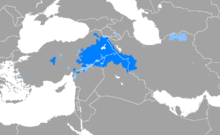Kurdish leid
Wastren Iranian leid
Kurdish is a Indo-Aryan leid that's speakers is tae be fund in the Northwast o Iran, the north o Iraq an the Sootheast o Turkey. It's sib wi the Persie leid.
| Kurdish leids | |
|---|---|
| Kurdî, کوردی | |
 | |
| Native tae | Turkey, Iraq, Iran, Sirie, Armenie, Azerbaijan, Georgie |
| Region | Kurdistan, Anatolie, Khorasan |
| Ethnicity | Kurds |
Native speakers | c. 20–30 million (2000–2010 est.)[1] |
Indo-European
| |
| Dialects |
|
| Hawar alphabet (Laitin script; uised mostly in Turkey an Sirie) Sorani alphabet (Perso-Arabic script; uised maistly in Iraq an Iran) Cyrillic alphabet (umwhile Soviet Union) Armenie alphabet (1921-29 in Soviet Armenie)[3][4][5] | |
| Offeecial status | |
Offeecial leid in | Template:Kintra data Kurdistan Region[7] |
Recognised minority leid in | |
| Leid codes | |
| ISO 639-1 | ku |
| ISO 639-2 | kur |
| ISO 639-3 | kur – inclusive codeIndividual codes: ckb – Soranikmr – Kurmanjisdh – Soothren Kurdishlki – Laki leid |
| Glottolog | kurd1259[14] |
| Linguasphere | 58-AAA-a (North Kurdish incl. Kurmanji & Kurmanjiki) + 58-AAA-b (Central Kurdish incl. Dimli/Zaza & Gurani) + 58-AAA-c (Sooth Kurdish incl. Kurdi) |
 | |
 | |
References
eedit- ↑ Anerly verra rough estimates are possible. SIL Ethnologue gies estimates, braken doun bi dialect group, totallin 31 million, but wi the caveat o "Very provisional figures for Northern Kurdish speaker population". Ethnologue estimates for dialect groups: Northren: 20.2M (undatit; 15M in Turkey for 2009), Central: 6.75M (2009), Soothren: 3M (2000), Laki: 1M (2000). The Swedish Nationalencyklopedin leetit Kurdish in its "Världens 100 största språk 2007" (The World's 100 Largest Languages in 2007), citin an estimate o 20.6 million native speakers.
- ↑ "Atlas of the Languages of Iran A working classification". Languages of Iran. Retrieved 25 Mey 2019.
- ↑ MacCagg, William O.; Silver, Brian D., eds. (1979). Soviet Asian Ethnic Frontiers. Pergamon Press. p. 94. ISBN 9780080246376.
Since the most active Soviet Kurdish center has been and continues to be Yerevan, the first alphabet used for publishing Kurdish in the USSR was the Armenian alphabet.
- ↑ Курдский язык (in Roushien). Krugosvet.
...в Армении на основе русского алфавита с 1946 (с 1921 на основе армянской графики, с 1929 на основе латиницы).
- ↑ Khamoyan, M. (1986). "Քրդերեն [Kurdish language]". Soviet Armenian Encyclopedia Volume 12 (in Armenian). p. 492.
...գրկ. լույս է տեսնում 1921-ից հայկ., 1929-ից՝ լատ., 1946-ից՝ ռուս. այբուբենով...
- ↑ "Iraq's Constitution of 2005" (PDF). p. 4. Retrieved 14 Apryle 2019.
- ↑ "Kurdistan: Constitution of the Iraqi Kurdistan Region". Retrieved 14 Apryle 2019.
- ↑ "Social Contract - Sa-Nes". Self-Administration of North & East Syria Representation in Benelux. Archived frae the original on 9 December 2018. Retrieved 22 Mairch 2019.
- ↑ ""Rojava could be a model for all Syria"". Salih Muslim. Nationalita. 29 Julie 2014. Retrieved 22 Mairch 2019.
- ↑ Pavlenko, Aneta (2008). Multilingualism in post-Soviet countries. Bristol, UK: Multilingual Matters. pp. 18–22. ISBN 978-1-84769-087-6.
- ↑ "Təhsil" (in Azerbaijani). Retrieved 6 Mey 2019.
- ↑ "Minority Language Education in Georgia". 15 August 2016. Retrieved 6 Mey 2019.
- ↑ "Report on the implementation of state strategy for civil equality and integration and 2016 action plan" (PDF). Retrieved 6 Mey 2019.
- ↑ Nordhoff, Sebastian; Hammarström, Harald; Forkel, Robert; Haspelmath, Martin, eds. (2013). "Kurdish". Glottolog. Leipzig: Max Planck Institute for Evolutionary Anthropology.
| This Turkey-relatit airticle is a stub. Ye can help Wikipaedia bi expandin it. |
| This Asie-relatit airticle is a stub. Ye can help Wikipaedia bi expandin it. |
| This leid-relatit airticle is a stub. Ye can help Wikipaedia bi expandin it. |